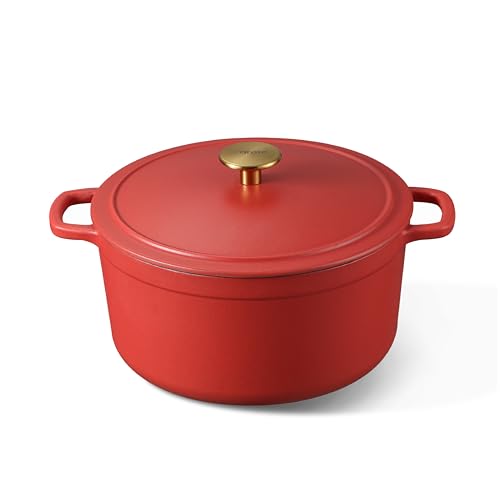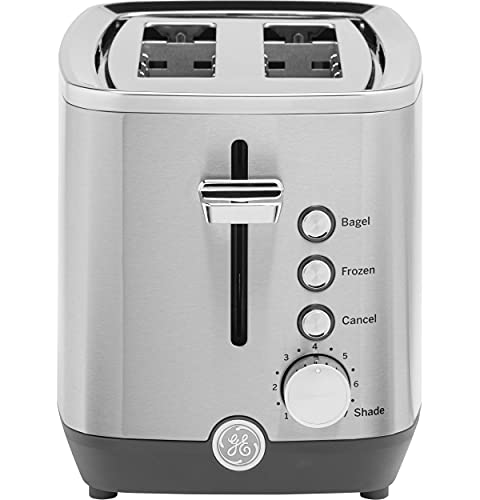Why Asparagus Is the Perfect Spring Vegetable
Asparagus stands out as the quintessential spring vegetable for many compelling reasons. First appearing in markets around April each year it signals the official arrival of spring cuisine. Its short growing season creates an urgency that makes asparagus particularly special among seasonal produce.
Nutritionally asparagus packs an impressive profile with minimal calories and maximum benefits. A single cup serving delivers essential nutrients while containing only about 40 calories making it an excellent choice for health-conscious eaters.
| Nutrient | Amount per Cup | % Daily Value |
|---|---|---|
| Vitamin K | 70% DV | 70% |
| Folate | 17% DV | 17% |
| Vitamin A | 20% DV | 20% |
| Vitamin C | 12% DV | 12% |
| Fiber | 3.6g | 13% |
The versatility of asparagus truly sets it apart from other spring vegetables. You can prepare it through various cooking methods including roasting grilling steaming sautéing or even enjoying it raw in salads. Each technique brings out different flavor notes from caramelized sweetness when roasted to bright crispness when barely blanched.
Flavor-wise asparagus offers a distinctive earthy taste with subtle grassy notes that pair wonderfully with spring ingredients. Its unique profile complements lemon butter Parmesan eggs and fresh herbs perfectly creating harmonious spring dishes that celebrate the season.
Asparagus comes in three main varieties each offering slightly different experiences. Green asparagus represents the most common type with its familiar flavor profile. White asparagus grown without sunlight exposure delivers a milder more delicate taste. Purple asparagus provides a sweeter flavor profile and beautiful color that fades when cooked but adds visual appeal to raw preparations.
Health Benefits of Asparagus
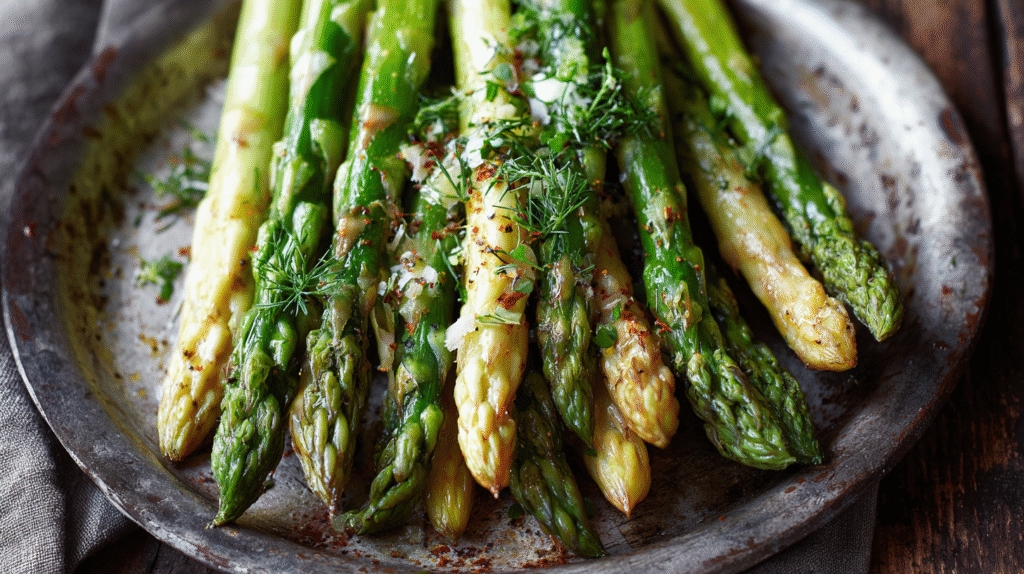
Asparagus stands out as a nutritional powerhouse that delivers impressive health benefits with minimal calories. This slender spring vegetable contains just 20 calories per 100g serving while offering substantial nutritional value that supports overall wellness.
Rich Source of Nutrients
Asparagus packs an exceptional nutrient profile that includes essential vitamins and minerals your body needs. Each serving provides important amounts of vitamin K crucial for bone health and proper blood clotting. Asparagus also delivers folate which supports cell division and DNA formation making it particularly valuable during pregnancy. Your immune system benefits from the vitamin C content while vitamin E acts as a powerful antioxidant protecting cells from damage.
The mineral content in asparagus deserves attention too. Potassium helps regulate blood pressure and supports proper muscle and nerve function. Phosphorus works alongside calcium to build strong bones and teeth. Iron in asparagus contributes to healthy red blood cell production and oxygen transport throughout your body.
Antioxidant Properties
Asparagus contains powerful antioxidant compounds that fight harmful free radicals in your body. Flavonoids including quercetin kaempferol and isorhamnetin help reduce inflammation and oxidative stress. These compounds potentially lower your risk of chronic diseases including certain cancers heart disease and type 2 diabetes.
The purple variety of asparagus offers even more antioxidant benefits thanks to anthocyanins which give it its distinctive color. These plant pigments provide additional protection against cellular damage and support brain health.
Digestive Health Benefits
Your digestive system gets important support from asparagus through its impressive fiber content. With approximately 2 grams of fiber per 100g serving asparagus promotes regular bowel movements and helps prevent constipation. This fiber also feeds beneficial gut bacteria supporting a healthy microbiome.
Asparagus contains inulin a type of prebiotic fiber that specifically nourishes beneficial bacteria in your digestive tract. This prebiotic effect may improve nutrient absorption reduce bloating and support overall gut health.
Anti-Inflammatory Effects
The anti-inflammatory compounds in asparagus help combat chronic inflammation associated with many health conditions. Saponins found in asparagus demonstrate anti-inflammatory properties that may reduce pain and swelling. Regular consumption might help manage symptoms of inflammatory conditions like arthritis.
Asparagus also contains glutathione a powerful antioxidant that supports your body’s natural detoxification processes while reducing inflammation. This compound helps your liver process and eliminate harmful substances more efficiently.
Weight Management Support
Adding asparagus to your meals supports weight management goals through multiple mechanisms. The high fiber content increases satiety helping you feel fuller longer after eating. With its low calorie density asparagus allows you to eat satisfying portions without consuming excess calories.
Asparagus acts as a natural diuretic due to an amino acid called asparagine. This property helps reduce water retention and bloating making it a popular choice before special events. The vegetable’s nutrient density ensures you receive essential vitamins and minerals even while reducing caloric intake.
| Nutrient | Amount per 100g | % Daily Value |
|---|---|---|
| Calories | 20 | 1% |
| Fiber | 2.1g | 8% |
| Protein | 2.2g | 4% |
| Vitamin K | 41.6μg | 52% |
| Folate | 52μg | 13% |
| Vitamin C | 5.6mg | 7% |
| Vitamin A | 756IU | 15% |
| Iron | 2.14mg | 12% |
How to Select and Store Fresh Asparagus

Selecting the Perfect Asparagus
When shopping for asparagus look for bright green or violet-tinged spears with firm stems and tight closed tips. Fresh asparagus stalks should stand straight and feel firm rather than limp or rubbery. The cut ends should appear moist and fresh not dried out or woody. Size doesn’t necessarily indicate quality but thicker stalks tend to be more tender and flavorful contrary to popular belief. Avoid bunches with flowering tips wrinkled stalks or those with a strong unpleasant odor as these are signs of age.
Seasonal asparagus typically available from February through June tastes best and costs less than off-season imports. Local farmers markets often offer the freshest options harvested within 24 hours while supermarket asparagus may have been in transit for several days. When possible choose organic asparagus to avoid pesticide residues that can be present on conventional varieties.
Proper Storage Techniques
Store unwashed asparagus properly to maintain its freshness and nutritional value for up to a week. Trim about an inch from the bottom of the stalks then stand them upright in a glass jar with about an inch of water. Loosely cover the tops with a plastic bag and refrigerate changing the water every couple of days if it becomes cloudy. This method keeps the stalks hydrated while allowing them to breathe.
Alternatively wrap the cut ends in a damp paper towel and place the bundle in a perforated plastic bag before refrigerating. For longer storage blanch the spears for 2-3 minutes cool them quickly in ice water then freeze in airtight containers or freezer bags for up to 8-10 months. Frozen asparagus works best in cooked dishes rather than raw applications as freezing alters the texture.
Preparing Asparagus Before Cooking
Before cooking asparagus rinse the spears thoroughly under cold running water to remove any grit especially around the tips. The woody bottom ends need removal since they’re tough and unpleasant to eat. Bend each stalk gently until it snaps naturally at the point where the tender part meets the tough base—usually 1-2 inches from the bottom. For a more uniform appearance you may prefer to cut all stems at once using the snapped stalk as a guide.
Peeling thick asparagus stalks with a vegetable peeler from just below the tips down to the cut ends creates a more tender result and promotes even cooking. Pat the spears dry with a clean kitchen towel before cooking especially if you plan to roast or sauté them as excess moisture prevents proper browning. Fresh properly prepared asparagus requires minimal cooking time to preserve its vibrant color crisp texture and nutritional benefits.
Essential Equipment for Cooking Asparagus
Preparing delicious asparagus dishes requires minimal but exact kitchen tools that enhance both the cooking process and final results. With the right equipment on hand you’ll transform those vibrant green spears into culinary masterpieces regardless of your chosen cooking method.
Basic Kitchen Tools
A sharp chef’s knife serves as your primary tool for trimming asparagus spears cleanly. Cutting boards with grooves help contain any liquid while prepping your asparagus. Vegetable peelers become essential when working with thicker asparagus stalks that benefit from peeling the fibrous exterior. Tongs allow you to flip and handle asparagus spears with precision especially when grilling or roasting. Kitchen shears offer another option for snipping off tough ends quickly and efficiently.
Cooking Vessels
Sauté pans with high sides provide ideal cooking surfaces for quick asparagus preparation with butter or olive oil. Wide skillets work wonderfully for cooking larger quantities while maintaining even heat distribution. Steamer baskets protect the delicate texture of asparagus while preserving nutrients during the steaming process. Sheet pans lined with parchment paper create the perfect surface for roasting asparagus evenly in the oven. Grill pans bring those beautiful char marks and smoky flavor to indoor asparagus cooking when outdoor grilling isn’t an option.
Specialized Equipment
Asparagus steamers feature tall narrow designs specifically created to steam asparagus upright keeping tips tender while properly cooking the stems. Microplane graters make adding citrus zest or hard cheese to your finished asparagus dishes effortless. Immersion blenders transform roasted or steamed asparagus into velvety soups within minutes. Air fryers deliver crispy asparagus fries with minimal oil usage and quick cooking times. Food processors equipped with slicing attachments help prepare asparagus quickly and uniformly for various recipes.
Serving Tools
Slotted spoons allow you to transfer steamed or blanched asparagus while leaving excess water behind. Serving platters with raised edges prevent asparagus from rolling off during presentation. Butter warmers provide the perfect vessel for melting compound butters to drizzle over your finished asparagus. Pasta serving tools work surprisingly well for serving long asparagus spears from cooking vessel to plate. Small ramekins hold dipping sauces or dressings that complement your perfectly cooked asparagus.
Simple Roasted Asparagus with Lemon and Parmesan
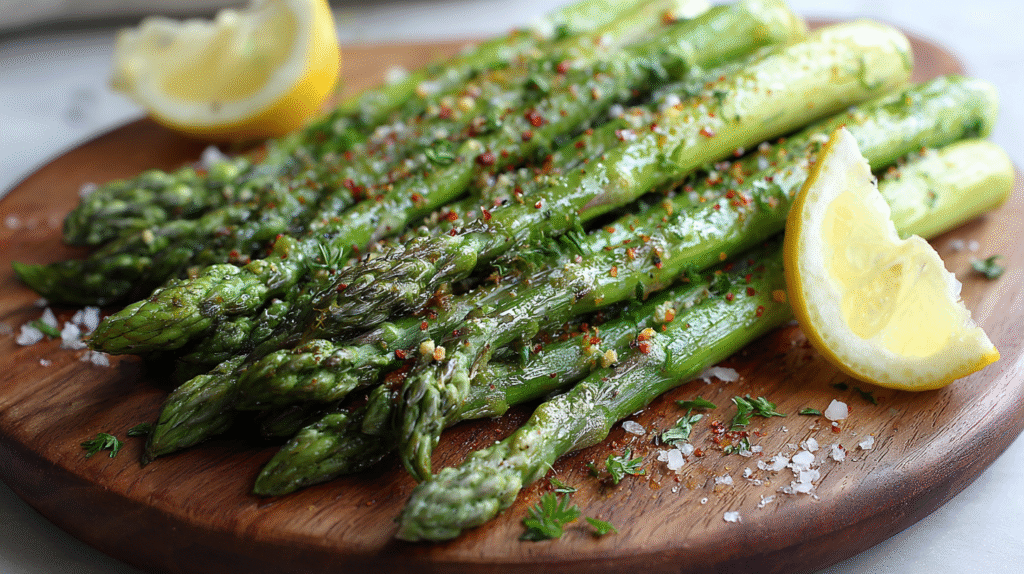
This classic roasted asparagus recipe highlights the natural flavors of fresh spring asparagus with bright lemon and savory Parmesan cheese. The high heat of roasting creates caramelized exteriors while maintaining a tender interior for a perfect side dish that comes together in minutes.
Ingredients
- 1 pound fresh asparagus spears
- 2 tablespoons olive oil
- 2 cloves garlic minced
- 1 tablespoon fresh lemon zest
- 2 tablespoons freshly squeezed lemon juice
- ½ teaspoon sea salt
- ¼ teaspoon freshly ground black pepper
- ⅓ cup freshly grated Parmesan cheese
- Lemon wedges for serving (optional)
Directions
Preheat your oven to 425°F (220°C) and position the rack in the center of the oven. Wash the asparagus thoroughly under cold running water to remove any grit or sand.
Trim the woody ends of the asparagus by gently bending each spear until it naturally snaps at the point where the tender part meets the tough base. Alternatively you can cut about 1-2 inches from the bottom ends with a sharp knife.
Place the trimmed asparagus on a large rimmed baking sheet in a single layer. Drizzle with olive oil and sprinkle with minced garlic salt and pepper.
Use your hands to toss the asparagus ensuring each spear is evenly coated with oil and seasonings. Arrange them back into a single layer with space between each spear for even roasting.
Roast in the preheated oven for 10-15 minutes depending on the thickness of your asparagus. Thin spears might need only 8 minutes while thicker ones could require up to 15 minutes. They should be tender when pierced with a fork but still maintain some firmness.
Remove the baking sheet from the oven and immediately sprinkle the hot asparagus with lemon zest lemon juice and freshly grated Parmesan cheese. The residual heat will slightly melt the cheese creating a light coating.
Transfer the roasted asparagus to a serving platter and garnish with additional Parmesan and lemon wedges if desired. Serve immediately while hot for the best flavor and texture.
Creamy Asparagus Soup
Transform fresh asparagus into a velvety soup that captures the essence of spring in every spoonful. This elegant yet simple soup makes a perfect starter for dinner parties or a comforting lunch on chilly spring days.
Ingredients
- 2 pounds fresh asparagus
- 3 tablespoons unsalted butter
- 1 medium onion, chopped
- 2 cloves garlic, minced
- 4 cups vegetable or chicken broth
- 1/2 cup heavy cream
- 1 tablespoon fresh lemon juice
- 1/2 teaspoon lemon zest
- Salt and freshly ground black pepper to taste
- 2 tablespoons fresh chives, chopped (for garnish)
- Croutons or toasted bread (optional, for serving)
Directions
Trim the woody ends from your asparagus spears and cut them into 1-inch pieces. Reserve a few asparagus tips for garnish if desired.
Melt butter in a large pot over medium heat until it begins to foam. Add the chopped onion and cook for 5-6 minutes until translucent and soft. Stir in the minced garlic and cook for another 30 seconds until fragrant.
Add the chopped asparagus to the pot and cook for 3-4 minutes until it turns bright green. Pour in the broth and bring the mixture to a boil. Reduce heat to maintain a gentle simmer and cook for 15-20 minutes until the asparagus is completely tender.
Remove the pot from heat and let the mixture cool slightly. Transfer the soup to a blender in batches and puree until completely smooth. You can also use an immersion blender directly in the pot for easier processing.
Return the pureed soup to the pot if using a standard blender. Stir in the heavy cream and warm over low heat without allowing it to boil. Add lemon juice and zest for brightness.
Season the soup with salt and freshly ground black pepper to taste. The amount will depend on the saltiness of your broth and your personal preference.
Ladle the hot soup into bowls and garnish with chopped fresh chives. Float a few of the reserved blanched asparagus tips on top for presentation if you set some aside. Serve immediately with croutons or toasted bread on the side.
For a lighter version, substitute the heavy cream with half-and-half or Greek yogurt. Store any leftover soup in an airtight container in the refrigerator for up to 3 days.
Asparagus and Prosciutto Tart
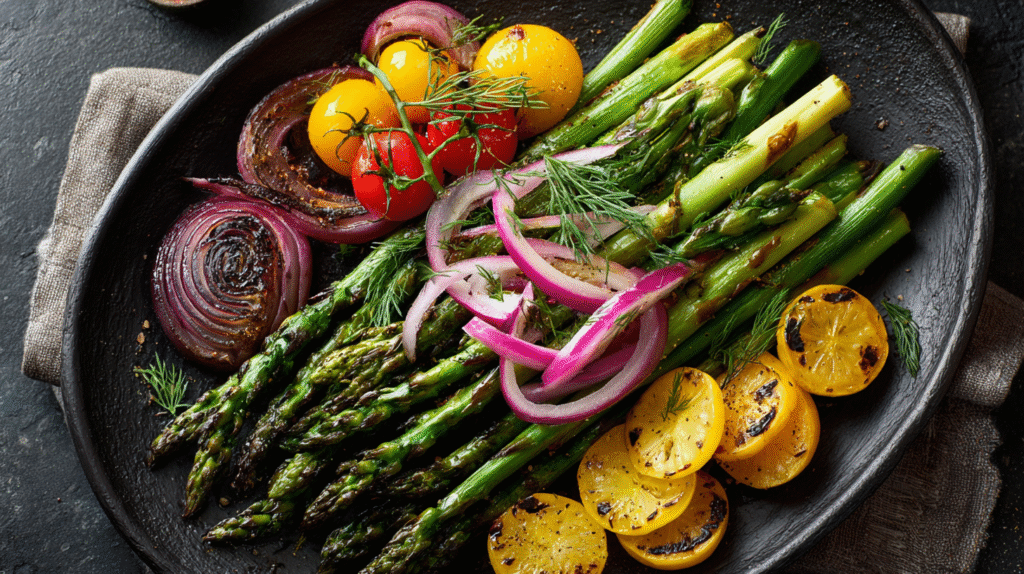
This elegant tart combines crisp asparagus spears with salty prosciutto on a buttery puff pastry base. Perfect for spring brunches or as an impressive appetizer this dish strikes the perfect balance between sophisticated flavor and simple preparation.
Ingredients
- 1 sheet frozen puff pastry (thawed)
- 2 tablespoons olive oil (divided)
- 1 pound fresh asparagus spears (trimmed)
- 4 ounces prosciutto (thinly sliced)
- 1 cup gruyère cheese (shredded)
- 2 tablespoons fresh thyme leaves
- 2 cloves garlic (minced)
- 1 lemon (zested)
- 2 tablespoons grated parmesan cheese
- 1 large egg (beaten for egg wash)
- Salt and freshly ground black pepper to taste
- Red pepper flakes (optional)
Directions
Preheat your oven to 400°F (200°C) and line a baking sheet with parchment paper. Unfold the thawed puff pastry onto the prepared baking sheet and gently roll it out to form a rectangle approximately 10×14 inches.
Score a 1-inch border around the edge of the pastry with a sharp knife being careful not to cut all the way through. Prick the center area several times with a fork to prevent it from puffing up too much during baking.
Brush the entire pastry with 1 tablespoon of olive oil then sprinkle the minced garlic over the center area. Spread the shredded gruyère cheese evenly over the center leaving the border clear.
Arrange the prosciutto slices in a single layer over the cheese. Toss the asparagus spears with the remaining olive oil salt and pepper then arrange them in a neat row across the tart alternating directions for visual appeal.
Sprinkle the fresh thyme leaves lemon zest and parmesan cheese over the asparagus. Brush the border with beaten egg to create a golden crust when baked.
Bake the tart for 20-25 minutes until the pastry is puffed and golden brown and the asparagus is tender. Remove from the oven and let it cool for 5 minutes before slicing.
Serve the tart warm or at room temperature cut into squares or rectangles. This versatile dish works beautifully as an appetizer for dinner parties a light lunch with a side salad or as part of a spring brunch spread.
Store any leftovers in an airtight container in the refrigerator for up to 2 days. Reheat in a 350°F oven for about 10 minutes to restore crispness before serving.
Grilled Asparagus with Balsamic Glaze
Transform fresh asparagus into a smoky delicacy with this simple grilling technique. The sweet and tangy balsamic glaze elevates this classic side dish to restaurant-quality status in minutes.
Ingredients
- 1 pound fresh asparagus spears
- 2 tablespoons olive oil
- 1 clove garlic (minced)
- ½ teaspoon sea salt
- ¼ teaspoon freshly ground black pepper
- ¼ cup balsamic vinegar
- 1 tablespoon honey
- 1 teaspoon fresh thyme leaves (optional)
- Zest of half a lemon
- Shaved Parmesan cheese for serving (optional)
Directions
Preheat your grill to medium-high heat (approximately 400°F). Wash the asparagus thoroughly under cold running water and pat dry with paper towels.
Trim the woody ends of the asparagus by either snapping them off at their natural breaking point or cutting approximately 1-2 inches from the bottom. Place the trimmed asparagus in a large shallow dish for easy seasoning.
Drizzle the asparagus with olive oil and sprinkle with minced garlic. Season with sea salt and freshly ground black pepper then toss gently to ensure even coating of the seasonings.
Arrange the seasoned asparagus perpendicular to the grill grates to prevent them from falling through. Grill for 3-4 minutes until grill marks appear then carefully turn and continue grilling for another 2-3 minutes until tender-crisp.
While the asparagus is grilling prepare the balsamic glaze by combining balsamic vinegar and honey in a small saucepan. Bring the mixture to a simmer over medium heat then reduce heat to low and cook for 5-7 minutes until the glaze thickens enough to coat the back of a spoon.
Transfer the grilled asparagus to a serving platter. Drizzle the warm balsamic glaze over the asparagus and sprinkle with fresh thyme leaves and lemon zest if using.
Serve immediately while hot garnished with shaved Parmesan if desired. This grilled asparagus pairs beautifully with grilled steaks chicken or fish and makes an impressive yet simple side dish for outdoor gatherings.
Asparagus Risotto
Transform seasonal asparagus into a luxurious Italian classic with this creamy risotto. This dish perfectly balances the earthy flavor of asparagus with rich Arborio rice and savory Parmesan cheese.
Ingredients
- 1 pound fresh asparagus spears
- 6 cups vegetable or chicken broth
- 2 tablespoons olive oil
- 1 medium onion finely diced
- 2 cloves garlic minced
- 1½ cups Arborio rice
- ½ cup dry white wine
- ½ cup freshly grated Parmesan cheese plus more for serving
- 2 tablespoons unsalted butter
- 1 tablespoon fresh lemon zest
- 2 tablespoons fresh lemon juice
- 2 tablespoons fresh parsley chopped
- Salt and freshly ground black pepper to taste
Directions
Begin by preparing your asparagus. Wash the spears thoroughly and snap off the woody ends. Cut the spears into 1-inch pieces reserving the tips separately from the stalks.
Bring the broth to a simmer in a medium saucepan over medium heat. Reduce the heat to low to keep the broth warm throughout the cooking process.
Heat olive oil in a large heavy-bottomed pot or Dutch oven over medium heat. Add the diced onion and cook for 3-4 minutes until translucent. Stir in the minced garlic and cook for another 30 seconds until fragrant.
Add the Arborio rice to the pot and stir continuously for 1-2 minutes until the grains are coated with oil and appear slightly translucent around the edges. Pour in the white wine and stir until completely absorbed.
Begin adding the warm broth one ladle at a time (about ½ cup) stirring frequently. Wait until each addition is almost completely absorbed before adding more. This process takes patience—about 18-22 minutes total.
After about 10 minutes of adding broth add the asparagus stalks to the risotto. Continue the process of adding broth and stirring until the rice is almost tender.
Add the asparagus tips during the final 5 minutes of cooking. The rice should be creamy yet al dente when done and the asparagus should be tender-crisp.
Remove the pot from heat and stir in the Parmesan cheese butter lemon zest lemon juice and chopped parsley. Season with salt and pepper to taste.
Let the risotto rest for 2 minutes before serving. Dish into warmed bowls and top with additional Parmesan cheese if desired. Serve immediately while the risotto maintains its perfect creamy consistency.
Asparagus Quiche
This savory Asparagus Quiche showcases tender spring asparagus in a creamy custard filling, all encased in a buttery, flaky crust. Perfect for brunches, light lunches, or dinner parties, this versatile dish celebrates asparagus as the star ingredient.
Ingredients
- 1 pre-made pie crust (or homemade)
- 1 pound fresh asparagus, trimmed and cut into 1-inch pieces
- 1 tablespoon olive oil
- 1 medium onion, finely chopped
- 2 cloves garlic, minced
- 4 large eggs
- 1 cup heavy cream
- 1/2 cup whole milk
- 1 1/2 cups grated Gruyère cheese (or Swiss cheese)
- 1/4 cup freshly grated Parmesan cheese
- 1 tablespoon fresh thyme leaves
- 1/2 teaspoon salt
- 1/4 teaspoon black pepper
- 1/8 teaspoon nutmeg
Directions
Preheat your oven to 375°F (190°C) and position a rack in the center. Roll out your pie crust and carefully transfer it to a 9-inch quiche dish or pie plate. Press the dough firmly against the bottom and sides of the dish then trim any excess dough hanging over the edges. Prick the bottom several times with a fork to prevent bubbling.
Line the crust with parchment paper and fill with pie weights or dried beans. Blind bake the crust for 15 minutes until it begins to set and turn light golden. Remove the weights and parchment paper then bake for an additional 5 minutes. Set aside while preparing the filling.
Blanch the asparagus in boiling water for just 2 minutes until bright green but still crisp. Immediately transfer to an ice bath to stop the cooking process. Drain thoroughly and pat dry with paper towels.
Heat olive oil in a skillet over medium heat. Add the chopped onion and sauté for 4-5 minutes until softened and translucent. Stir in the minced garlic and cook for another 30 seconds until fragrant. Remove from heat and let cool slightly.
Whisk together eggs cream and milk in a large bowl until well combined. Add the Gruyère cheese Parmesan thyme salt pepper and nutmeg. Stir in the cooled onion and garlic mixture.
Arrange two-thirds of the blanched asparagus pieces evenly across the bottom of the par-baked crust. Pour the egg mixture over the asparagus. Arrange the remaining asparagus pieces decoratively on top of the filling pressing them in slightly.
Bake the quiche for 35-40 minutes until the center is just set and the top is golden brown. The quiche should be slightly jiggly in the center but not liquid. Let the quiche rest for at least 15 minutes before slicing.
Serve your asparagus quiche warm or at room temperature for the best flavor. Store any leftovers covered in the refrigerator for up to 3 days and reheat individual slices in a 325°F oven for about 10 minutes.
Make-Ahead Asparagus Recipes
Busy schedules shouldn’t prevent you from enjoying fresh asparagus dishes. These make-ahead recipes allow you to prep in advance while preserving the vibrant flavor and nutritional benefits of this spring vegetable.
Marinated Asparagus Salad
This refreshing salad actually improves with time as the flavors meld together. Simply blanch 2 pounds of asparagus until bright green and tender-crisp then shock in ice water to stop the cooking process. Slice the cooled spears into 2-inch pieces and toss with a dressing of:
- ¼ cup extra virgin olive oil
- 3 tablespoons white wine vinegar
- 1 teaspoon Dijon mustard
- 2 cloves minced garlic
- 1 tablespoon fresh chopped herbs (dill parsley or basil)
- Salt and pepper to taste
Add cherry tomatoes red onion slices and crumbled feta cheese to complete the salad. Store in an airtight container for up to 3 days in the refrigerator allowing the asparagus to absorb the tangy dressing.
Asparagus and Leek Frittata
Frittatas taste delicious hot or cold making them perfect for meal prep. Begin by sautéing 1 thinly sliced leek and 1 bunch of asparagus (cut into 1-inch pieces) in olive oil until tender. Whisk together 8 eggs 2 tablespoons heavy cream ½ cup grated Parmesan cheese salt and pepper. Pour the egg mixture over the vegetables in an oven-safe skillet and cook until edges begin to set. Transfer to a 375°F oven and bake for 12-15 minutes until puffed and golden.
Cool completely before slicing into wedges and storing in the refrigerator for up to 4 days. Enjoy this protein-rich dish for breakfast lunch or dinner with a simple side salad.
Asparagus Soup with Lemon Cream
This vibrant soup can be prepared days in advance and reheated when needed. Start by sautéing 1 chopped onion and 2 minced garlic cloves in butter until translucent. Add 2 pounds of chopped asparagus (woody ends removed) and cook for 3 minutes. Pour in 4 cups of vegetable broth bring to a simmer and cook until asparagus is tender about 10 minutes.
Blend until smooth using an immersion blender then stir in ¼ cup of heavy cream salt and pepper. For the lemon cream garnish mix ½ cup sour cream with 1 tablespoon lemon zest and 1 teaspoon lemon juice. Refrigerate the soup for up to 3 days or freeze for up to 2 months. When ready to serve reheat gently and top with a dollop of the lemon cream.
Asparagus and Goat Cheese Tart
Prepare this elegant tart ahead of time for stress-free entertaining. Roll out 1 sheet of puff pastry on a parchment-lined baking sheet and score a 1-inch border around the edges. Spread 4 ounces of softened goat cheese mixed with 1 tablespoon fresh thyme leaves within the border. Arrange 1 pound of trimmed asparagus spears over the cheese mixture and brush with olive oil. Season with salt and pepper.
Bake at 400°F for 20-25 minutes until the pastry is golden and asparagus is tender. Cool completely before covering and refrigerating. The tart can be made up to 2 days ahead and served at room temperature or briefly reheated before serving.
Pickled Asparagus Spears
Transform asparagus into a tangy condiment that lasts for weeks in your refrigerator. Trim 2 pounds of asparagus to fit vertically in mason jars. In a saucepan combine:
- 2 cups white vinegar
- 2 cups water
- 2 tablespoons kosher salt
- 2 tablespoons sugar
- 2 teaspoons mustard seeds
- 1 teaspoon red pepper flakes
- 4 garlic cloves peeled
- 1 tablespoon black peppercorns
Bring the mixture to a boil then remove from heat. Pack asparagus spears tightly into sterilized jars along with fresh dill sprigs. Pour the hot brine over asparagus ensuring all spears are submerged. Seal and refrigerate for at least 24 hours before enjoying. These pickled spears last up to 3 weeks refrigerated and make excellent additions to charcuterie boards Bloody Marys or as a tangy side dish.
Seasonal Pairings for Asparagus Dishes
Spring brings an abundance of fresh ingredients that complement asparagus perfectly. Understanding how to pair this versatile vegetable with seasonal produce enhances your culinary creations and showcases the best flavors of the season.
Spring Produce Companions
Fresh spring peas create a beautiful color contrast and textural balance when served alongside asparagus. Their natural sweetness offsets the earthy notes of asparagus spears. New potatoes with their delicate skin and buttery interior make an excellent starchy companion that absorbs the flavors of any sauce you might serve with your asparagus dish. Young spring garlic offers a milder flavor than mature bulbs and works wonderfully in asparagus stir-fries or pasta dishes.
Tender young radishes provide a peppery crunch that contrasts beautifully with the softness of cooked asparagus. Try them sliced raw in an asparagus salad or roasted alongside spears for a colorful side dish. Fresh herbs like chervil dill and tarragon burst with flavor during spring months and enhance asparagus with their aromatic qualities. Artichokes share a similar season with asparagus and pair beautifully in Mediterranean-inspired dishes.
Protein Pairings
Eggs and asparagus form a classic partnership that spans breakfast lunch and dinner options. The rich yolk creates a natural sauce that coats asparagus beautifully whether poached fried or folded into an omelet. Delicate white fish such as halibut or sole offers a subtle flavor that doesn’t overpower asparagus allowing both ingredients to shine. Spring lamb with its tender texture and mild flavor complements asparagus perfectly especially when both are simply prepared with herbs and lemon.
Shellfish like scallops and shrimp cook quickly just like asparagus making them natural pairing partners for quick elegant meals. Prosciutto wrapped around asparagus spears delivers a salty contrast to the vegetable’s grassy notes while creating an impressive appetizer with minimal effort.
Wine and Beverage Matches
Sauvignon Blanc with its bright acidity and herbaceous notes mirrors similar qualities in asparagus creating a harmonious pairing. Grüner Veltliner from Austria has become known as perhaps the best wine to serve with asparagus thanks to its ability to complement rather than clash with the vegetable’s unique compounds.
| Wine Variety | Flavor Profile | Best Asparagus Preparation |
|---|---|---|
| Sauvignon Blanc | Bright herbaceous citrusy | Steamed or roasted with lemon |
| Grüner Veltliner | Mineral crisp white pepper | Grilled or sautéed with herbs |
| Albariño | Zesty floral stone fruit | Raw shaved in salads |
| Dry Riesling | Citrus apple mineral notes | Asian-inspired dishes |
| Champagne | Bright effervescent complex | Asparagus appetizers |
Spring cocktails featuring herbal notes like a cucumber gin and tonic or a basil smash provide refreshing accompaniments to asparagus dishes during warmer months. Fresh lemonade infused with mint or lavender creates a non-alcoholic option that cleanses the palate between bites of asparagus.
Sauce and Condiment Companions
Hollandaise sauce with its rich buttery texture and lemon brightness stands as the classic accompaniment to asparagus. The sauce’s velvety consistency coats each spear perfectly. Aioli whether classic garlic or flavored with herbs provides a creamy dipping option that enhances asparagus’s natural flavors especially when the spears are served as finger food.
Brown butter with its nutty toasted flavor transforms simple steamed asparagus into something extraordinary with just a drizzle. Citrus vinaigrettes made with lemon orange or grapefruit juice cut through the earthiness of asparagus while adding brightness to any preparation. Miso butter combines umami richness with creamy texture creating a Japanese-inspired topping that works beautifully with grilled or roasted asparagus.
Dessert Pairings
Lemon desserts like tarts soufflés or sorbets provide a refreshing conclusion to a meal featuring asparagus by cleansing the palate with bright citrus notes. Fresh strawberries at their peak during late spring pair wonderfully following an asparagus main course offering natural sweetness and vibrant color.
Rhubarb with its tartness and beautiful pink hue complements an asparagus menu by providing contrast in both flavor and appearance. Light vanilla panna cotta allows diners to finish their meal on a delicate note without overwhelming the lingering flavors of your asparagus dishes.
Conclusion
Asparagus truly earns its reputation as spring’s most versatile vegetable. From simple roasted spears with lemon to elegant risottos and savory quiches you’ll find endless ways to incorporate this nutritional powerhouse into your meals.
The beauty of asparagus lies not just in its distinct earthy flavor but in how it pairs with other seasonal ingredients. Whether you’re grilling it with balsamic glaze for a weekend barbecue or preparing make-ahead dishes for busy weeknights you’ll appreciate its adaptability.
With the right techniques and tools you can transform this humble vegetable into restaurant-worthy dishes that impress without excessive effort. So grab a bunch while it’s in season and let asparagus bring the fresh taste of spring to your table.






































